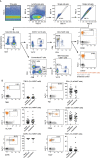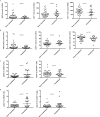MAIT cell counts are associated with the risk of hospitalization in COPD
- PMID: 35585629
- PMCID: PMC9114286
- DOI: 10.1186/s12931-022-02045-2
MAIT cell counts are associated with the risk of hospitalization in COPD
Abstract
Background: Chronic obstructive pulmonary disease (COPD) is characterized by persistent airflow limitation associated with chronic inflammation in the airways. Mucosal-associated invariant T (MAIT) cells are unconventional, innate-like T cells highly abundant in mucosal tissues including the lung. We hypothesized that the characteristics of MAIT cells in circulation may be prospectively associated with COPD morbidity.
Methods: COPD subjects (n = 61) from the Tools for Identifying Exacerbations (TIE) study were recruited when in stable condition. At study entry, forced expiratory volume in 1 s (FEV1) was measured and peripheral blood mononuclear cells were cryopreserved for later analysis by flow cytometry. Patients were followed for 3 years to record clinically meaningful outcomes.
Results: Patients who required hospitalization at one or more occasions during the 3-year follow-up (n = 21) had lower MAIT cell counts in peripheral blood at study inclusion, compared with patients who did not get hospitalized (p = 0.036). In contrast, hospitalized and never hospitalized patients did not differ in CD8 or CD4 T cell counts (p = 0.482 and p = 0.221, respectively). Moreover, MAIT cells in hospitalized subjects showed a more activated phenotype with higher CD38 expression (p = 0.014), and there was a trend towards higher LAG-3 expression (p = 0.052). Conventional CD4 and CD8 T cells were similar between the groups. Next we performed multi-variable logistic regression analysis with hospitalizations as dependent variable, and FEV1, GOLD 2017 group, and quantity or activation of MAIT and conventional T cells as independent variables. MAIT cell count, CD38 expression on MAIT cells, and LAG-3 expression on both MAIT and CD8 T cells were all independently associated with the risk of hospitalization.
Conclusions: These findings suggest that MAIT cells might reflect a novel, FEV1-independent immunological dimension in the complexity of COPD. The potential implication of MAIT cells in COPD pathogenesis and MAIT cells' prognostic potential deserve further investigation.
Keywords: COPD; Human; Immune activation; MAIT cells; T cells.
© 2022. The Author(s).
Conflict of interest statement
The authors declare that they have no competing interests.
Figures



References
MeSH terms
Grants and funding
LinkOut - more resources
Full Text Sources
Medical
Research Materials
Miscellaneous

